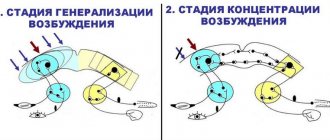CONDITIONED REFLEX.
A term that was first used by Russian physiologist I.P. Pavlov to describe an acquired reflex, i.e. which is not (unlike an unconditioned reflex) innate, and therefore characteristic of an individual, and not all representatives of a given species. When lemon juice hits the tongue, saliva is released - this is an unconditioned reflex. However, saliva can also be released at the sight of a lemon or at the sound of the word “lemon” - this is a conditioned reflex. The difference is that the sight of lemon or the sound of the word does not always cause salivation and, in addition, may not have an effect on certain people. Such stimuli acquire the ability to produce a response only after they have been presented more or less simultaneously with the stimulation of the taste buds by lemon juice. The sight of a lemon or the sound of the word “lemon” in this case turns out to be conditioned (signal) stimuli that replace the unconditioned stimulus – lemon juice.
Development of classical conditioning theory
The study of conditioned reflexes led to the emergence of the theory of conditioning, which consists of the influence of an initially neutral stimulus on the brain.
A neutral stimulus, associatively attached to a stimulus that certainly generates a certain reaction, causes the same reaction. These data subsequently had a huge impact on the development of psychology.
In gratitude for the help and sacrifices made by four-legged animals for the sake of science, Pavlov ordered and erected a monument to an unknown dog in the park of the building of the Institute of Experimental Medicine in St. Petersburg on Aptekarsky Island.
Tags
- Aggression
- Alexander Romanovich Luria
- Alexey Nikolaevich Leontyev
- Alfred Adler
- Analytical psychology
- Aristotle
- Burress Skinner
- Behaviorism
- Boris Gerasimovich Ananyev
- Video
- Vladimir Mikhailovich Bekhterev
- Wolfgang Keller
- Hermann Ebbinghaus
- Gestalt psychology
- Gosy
- Gustav Fechner
- Daniil Borisovich Elkonin
- John Watson
- Donald Norman
- Jean Piaget
- Sigmund Freud
- Ivan Mikhailovich Sechenov
- Ivan Petrovich Pavlov
- Individual psychology
- Intelligence
- Carl Jung
- Cognitive psychology
- Kurt Koffka
- Kurt Lewin
- Lev Semyonovich Vygotsky
- Lectures on psychology
- Personality
- Max Wertheimer
- Mario Ponzo
- Violations
- Domestic psychology
- Mental processes
- Psychoanalysis
- Pyotr Yakovlevich Galperin
- Theories
- Ulrich Neisser
- Charles Sherrington
- Edward Thorndike
- Experiments
- Ernst Weber
The essence of developing a conditioned reflex according to Pavlov’s method
To carry out Pavlov's famous experiment, it was required:
- Test subjects (dogs);
- An unconditioned stimulus that stimulates the production of saliva in a dog (food);
- Neutral stimulus (sound or light);
In order to achieve the desired result, the experimental subjects were repeatedly exposed to neutral stimuli, such as the light of a light bulb or the sound of a metronome during feeding. After some time, the dogs developed a conditioned reflex in the form of salivation to unconditioned stimuli, such as light or sound.
Criticism of Sechenov's ideas in Russia
Society (especially Russian) did not immediately accept the theory of the brilliant physiologist. After the book “Reflexes of the Brain” was published, some of the scientist’s articles were no longer published in Sovremennik. Sechenov boldly attacked theological church ideas. He was a materialist and tried to prove everything from the point of view of physiological processes.
Despite the controversial assessment in Russia, the fundamentals of the theory of reflex activity were warmly received by the scientific community of the Old World. Sechenov's books began to be published in Europe in gigantic editions. The scientist even moved his main research activities to Western laboratories for some time. He worked productively with the French physician Claude Bernard.
What did Pavlov do?
Every creature on the planet is born with a set of reflexes laid down by Mother Nature, the rest were acquired in the process of evolution, for better adaptation to the environment, thus increasing the chance of survival.
In 1903, the world first learned about conditioned and unconditioned reflexes, which were discovered by the scientist Ivan Petrovich Pavlov. Thanks to his scientific works, written based on the results of experiments on dogs, a year later he received the Nobel Prize.
Read also: How to install a toggle switch in a car
The scientist was interested in this reaction in animals, because their behavior was the same in a situation when an assistant brought food and when he simply entered the laboratory in a white coat with inedible objects.
Pavlov was the first scientist to hypothesize that intense secretion from the salivary glands is not a physiological, but a reflex process caused by repeated repetition of the same actions related to eating food.
In this educational video, biologist Anton Gorovanin will briefly explain what this experiment involving animals involved:
World of Psychology
to the Table of Contents
Part I GENERAL PSYCHOLOGY
I.P. Pavlov. Conditioned reflex
Conditioned reflex is now a separate physiological term denoting a certain nervous phenomenon, a detailed study of which led to the formation of a new department in animal physiology - the physiology of higher nervous activity as the first chapter of the physiology of the higher part of the central nervous system. Empirical and scientific observations have long been accumulated that mechanical damage or disease of the brain and especially the cerebral hemispheres caused a violation of the highest, most complex behavior of animals and humans, usually called mental activity... Then a persistent fundamental question will arise: what is the connection between the brain and the higher activity of animals and ourselves and where and how to start studying this activity? It would seem that mental activity is the result of the physiological activity of a certain mass of the brain, and from the physiological side it should have been studied, just as the activity of all other parts of the body is now being successfully studied. And yet, this did not happen for a long time. Mental activity has long been (more than one millennium) become the object of study of a special science - psychology. And physiology, amazingly recently, only from the 70th year of the last century, using its usual method of artificial stimulation, received the first accurate facts regarding a certain (namely motor) physiological function of the cerebral hemispheres; with the help of another, also conventional, method of partial destruction, additional data were acquired regarding the establishment of connections between other parts of the hemispheres and the main receptors of the body: the eye, ear and others. This aroused the hopes of both physiologists and psychologists regarding the close connection between physiology and psychology. But disappointment soon set in in both camps. The physiology of the hemispheres stopped noticeably at these first experiments and did not move significantly further. And among psychologists after this, again, as before, there were many determined people who stood for the complete independence of psychological research from physiological research. Along with this, there were other attempts to connect the triumphant natural sciences with psychology through the method of numerical measurement of mental phenomena. At one time it was thought to form a special department of psychophysics in physiology thanks to the happy discovery by Weber and Fechner of the law (called after them) of a certain numerical relationship between the intensity of external stimulation and the strength of sensation.
However, another way to solve the fundamental question was felt, imagined and outlined. Is it not possible to find such an elementary mental phenomenon that could rightfully be considered at the same time a pure physiological phenomenon, and, starting with it, studying strictly objectively (like everything in physiology) the conditions of its occurrence, its various complications and its disappearance , - first obtain an objective physiological picture of all higher activity of animals, i.e. normal functioning of the higher part of the brain instead of all sorts of experiments previously carried out on its artificial irritation and destruction?.. This phenomenon was what the term “conditioned reflex” now means... Let’s set up and do two simple experiments that will work for everyone. Pour a moderate solution of some acid into the dog’s mouth. It will provoke the animal’s usual defensive reaction: with energetic movements of the mouth, the solution will be thrown out, out, and at the same time saliva will flow abundantly into the mouth (and then out), diluting the injected acid and washing it away from the mucous membrane of the mouth. Now it's a different experience. We will apply any external agent, for example a certain sound, to the dog several times just before introducing the same solution into its mouth. And what? It will be enough to repeat just this sound - and the dog will reproduce the same reaction: the same mouth movements and the same flow of saliva.
Both of these facts are equally accurate and constant. And both of them should be designated by the same physiological term “reflex”.
It’s most natural to imagine things this way. In the first reflex there was direct conduction of the nerve current, in the second the preliminary formation of a path for the nerve current must be made... Thus, in the central nervous system there are two different central apparatuses: the direct conduction of the nerve current and the apparatus for closing and opening it. It would be strange to stand in some kind of bewilderment before such a conclusion. After all, the nervous system on our planet is an inexpressibly complex and subtle instrument of communication, communication between numerous parts of the body and the body as a complex system with an infinite number of external influences... An animal organism as a system exists among the surrounding nature only thanks to the continuous balancing of this system with the external environment, i.e. .e. thanks to certain reactions of the living system to stimuli falling on it from the outside, which in higher animals is carried out primarily with the help of the nervous system in the form of reflexes. The first guarantee of balance, and therefore the integrity of an individual organism, as well as its species, consists of unconditioned reflexes, both the simplest (for example, coughing when foreign bodies enter the windpipe) and the most complex, usually called instincts - food, defensive, sexual etc. These reflexes are excited both by internal agents that arise in the body itself, and by external ones, which determines the perfection of balancing. But the balance achieved by these reflexes would be perfect only if the external environment was absolutely constant. And since the external environment, despite its extreme diversity, is at the same time in constant fluctuation, unconditional connections as permanent connections are not enough and it is necessary to supplement them with conditioned reflexes, temporary connections.
For example, it is not enough for an animal to take into its mouth only the food in front of it, then it would often starve and die of starvation, but it must be found according to various random and temporary signs, and these are conditioned (signal) stimuli that excite the animal’s movements in the direction to food, which end with its introduction into the mouth, i.e., in general, they cause a conditioned food reflex. The same applies to everything that is necessary for the well-being of the organism and the species, both in a positive and negative sense, i.e. to what needs to be taken from the environment and what to be protected from. It doesn’t take much imagination to immediately see what an incalculable number of conditioned reflexes are constantly practiced by the most complex human system, placed in the often widest not only natural environment, but also in a specially social environment, on its extreme scale to the extent of all mankind... So, temporary nervous connection is the most universal physiological phenomenon in the animal world and in ourselves. And at the same time, it is also mental - what psychologists call association; whether it be the formation of compounds from all kinds of actions, impressions or letters, words and thoughts. What reason would there be to somehow distinguish, to separate from each other what a physiologist calls a temporary connection, and a psychologist calls an association? Here there is complete fusion, complete absorption of one by the other, identification... For physiology, the conditioned reflex became a central phenomenon, using which it was possible to study both normal and pathological activity of the cerebral hemispheres more fully and accurately.
A conditioned reflex is formed on the basis of all unconditioned reflexes and from all kinds of agents of the internal and external environment, both in elementary form and in complex complexes, but with one limitation: from everything for which there are receptor elements in the cerebral hemispheres for perception. We see the broadest synthesis carried out by this part of the brain.
But this is not enough. At the same time, the conditioned temporary connection specializes to the greatest complexity and to the smallest detail of both conditioned stimuli and certain activities of the body, especially skeletal and verbal-motor. We have before us the finest analysis as a product of the same cerebral hemispheres. Hence the enormous breadth and depth of adaptability, the balancing of the organism with the environment. Synthesis is obviously a phenomenon of nervous closure. What is analysis as a nervous phenomenon? Here are several separate physiological phenomena* The first basis for analysis is given by the peripheral endings of all afferent nerve conductors of the body, each of which is designed specifically to transform a certain type of energy (both outside and inside the body) in the process of nervous stimulation, which is then carried out both in special, more meager in number, the cells of the lower parts of the central nervous system, as well as the most numerous special cells of the cerebral hemispheres. Here, however, the incoming process of nervous irritation usually spreads out and radiates through different cells over a greater or lesser distance. That is why, when we have developed, let’s say, a conditioned reflex to one specific tone, then not only other tones, but also many other sounds cause the same conditioned reaction. In the physiology of higher nervous activity this is called generalization of conditioned reflexes. Consequently, the phenomena of closure and irradiation simultaneously occur here. But then the irradiation is gradually more and more limited; the irritative process is concentrated in the smallest nerve point of the hemispheres, probably in a group of corresponding special cells. Restriction most quickly occurs through another basic neural process called inhibition.
From this we must conclude that the inhibitory process radiates in the same way as the irritable one. But the more often non-reinforced tones are repeated, the less irradiation of inhibition becomes, and the inhibitory process becomes more and more concentrated both in time and in space. Consequently, the analysis begins with the special work of the peripheral apparatus of the afferent conductors and ends in the cerebral hemispheres through the inhibitory process. The described case of inhibition is called differential inhibition. Let us present other cases of braking. Usually, in order to have a certain, more or less constant value of the conditioned effect, the action of the conditioned stimulus is continued for a certain time and then an unconditioned stimulus is added to it and reinforced. Then the first seconds or minutes of irritation, depending on the duration of the isolated application of the conditioned stimulus, have no effect, because as premature, as signals of the unconditioned stimulus, they are inhibited. This is an analysis of different moments of the ongoing Radiator. This inhibition is called inhibition of the delayed reflex. But the conditioned stimulus, as a signal stimulus, is corrected by inhibition on its own, becoming gradually null if it is not accompanied by reinforcement in a certain period of time. This is extinction inhibition. This inhibition lasts for some time and then disappears by itself. The restoration of the extinct conditioned meaning of the stimulus is accelerated by reinforcement. Thus, we have positive conditioned stimuli, i.e. causing an irritative process in the cerebral cortex, and negative ones, causing an inhibitory process. In the above cases we have special inhibition of the cerebral hemispheres, cortical inhibition. It arises under certain conditions where it was not there before, it increases in size, it disappears under other conditions, and in this it differs from the more or less constant and persistent inhibition of the lower parts of the central nervous system and therefore is named in contrast to the latter (external ) internal. The name would be more correct; developed, conditioned inhibition. Inhibition is involved in the work of the cerebral hemispheres as constantly, complexly and subtly as the irritable process.
Among the conditions that determine the onset and course of irradiation and concentration of processes, the strength of these two processes must be considered in the first place. The material collected so far allows us to conclude that with a weak irritative process irradiation occurs, with a medium one - concentration, with a very strong one - irradiation again. Exactly the same with the braking process. Cases of irradiation during very strong processes were less common and therefore less studied, especially during braking. Irradiation of the irritable process with weak tension... eliminates the inhibitory state of other points of the cortex. This phenomenon is called disinhibition, when the irradiation wave of an extraneous weak stimulus transforms the action of a certain existing negative conditioned stimulus into the opposite, positive one. With average tension of the irritable process, it concentrates, concentrating in a certain limited point, expressing itself in a certain work. Irradiation with very strong irritation causes a higher tone of the cortex, when, against the background of this irritation, all other alternating irritations produce the maximum effect. The irradiation of the inhibitory process with weak tension is what is called hypnosis, and with food conditioned reflexes it is typically found in both components - secretory and motor. When inhibition (differentiation and others) occurs under the above conditions, the most common fact is the onset of special states of the cerebral hemispheres. First, against the rule of a more or less parallel normal change in the magnitude of the salivary effect of conditioned food reflexes according to the physical intensity of the stimuli, all stimuli are equalized in effect (equalization phase). Further, weak stimuli produce more saliva than strong ones (paradoxical phase). And finally, the effects are distorted; the conditioned positive stimulus remains completely without effect, and the negative one causes salivation (ultraparadoxical phase). The same applies to the motor reaction; Thus, when the dog is offered food (i.e., natural conditioned stimuli act), it turns away from it, and when the food is taken away, it is carried away - it reaches for it. In addition, in hypnosis one can sometimes directly see in the case of food conditioned reflexes the gradual spread of inhibition throughout the motor area of the cortex. First of all, the tongue and masticatory muscles are paralyzed, then the neck muscles are inhibited, and finally all the trunk muscles. With the further spread of inhibition down the brain, a cataleptic state can sometimes be noticed and, finally, complete sleep sets in...
When the braking process intensifies, it becomes concentrated. This serves to differentiate a cortical point with a state of irritation from points with an inhibitory state. And since the cortex contains a mass of various points, irritable and inhibitory, relating both to the external world (visual, auditory, etc.) and to the internal (motor, etc.), the cortex represents a grandiose mosaic with alternating points of different qualities and different degrees of tension of irritable and inhibitory states. Thus, the alert working state of animals and humans is a mobile and at the same time localized, sometimes larger, sometimes smaller fragmentation of the irritable and inhibitory state of the cortex, contrasting with the sleepy state, when inhibition at the height of its intensity and extensiveness spreads evenly throughout the entire mass of the hemispheres and in depth , down a known distance. However, now, individual irritable points - sentinel, duty - can sometimes remain in the cortex. Consequently, both processes in an alert state are in constant moving equilibrium, as if in a struggle. If a lot of external or internal irritations immediately disappear, then in the cortex inhibition takes a sharp advantage over irritation. Some dogs with peripherally destroyed main external receptors sleep 23 hours a day.
Next to the law of irradiation and concentration of nervous processes, another fundamental law is also constantly in effect - the law of mutual induction, which consists in the fact that the effect of a positive conditioned stimulus is greater when the latter is applied immediately or soon after a concentrated inhibitory one, just as the inhibitory effect turns out to be more accurate and deep after concentrated positive. Mutual induction is found both in the circumference of the point of stimulation or inhibition simultaneously with their action, and at the point itself after the cessation of the processes. It is clear that the law of irradiation and concentration and the law of mutual induction are closely related to each other, mutually limiting, balancing and strengthening each other and thus determining the exact relationship between the activity of the organism and the conditions of the external environment. Both of these laws are found in all parts of the central nervous system... In addition to these two different cases of inhibition, there is a third in the cerebral hemispheres. When conditioned stimuli are physically very strong, then the rule of direct connection between the magnitude of the effect of these stimuli and their physical intensity is violated; their effect is not greater, but less than the effect of stimuli of moderate strength - the so-called transcendental inhibition. Transcendental inhibition occurs both with one very strong conditioned stimulus, and in the case of the summation of individually not very strong stimuli.
The entire installation and distribution throughout the cerebral cortex of irritable and inhibitory states that occurred in a certain period under the influence of external and internal stimuli, under a monotonous, repeating situation, are increasingly fixed, occurring more easily and automatically. In this way, a dynamic stereotype (systematicity) is obtained in the cortex, the support of which requires less and less nervous labor; the stereotype becomes inert, often difficult to change, difficult to overcome by a new situation, new irritations. Depending on the complexity of the system of stimuli, any initial establishment of a stereotype requires significant and often extraordinary work.
All of the above obviously represents indisputable physiological material, i.e. objectively reproduced normal physiological work of the higher part of the central nervous system; It is with the study of normal functioning that we must begin, and indeed the physiological study of each part of the animal organism usually begins. This, however, does not prevent some physiologists from still considering the reported facts not related to physiology. Not a rare case of routine in science!
It is not difficult to bring the described physiological work of the higher part of the animal’s brain into a natural and direct connection with the phenomena of our subjective world at many points.
Who would separate the physiological somatic from the mental in the unconditioned most complex reflexes (instincts), i.e. from experiencing powerful emotions of hunger, sexual desire, anger, etc.? Our feelings of pleasant, unpleasant, ease, difficulty, joy, torment, triumph, despair, etc. are associated either with the transition of the strongest instincts and their stimuli into corresponding effector acts, or with their arrest, with all variations of either easy or difficult course of nervous processes occurring in the cerebral hemispheres... Our contrasting experiences are, of course, phenomena of mutual induction. With radiated excitement, we say and do things that we would not allow in a calm state. Obviously, the wave of excitement turned the inhibition of some points into a positive process. A strong decline in the memory of the present - a common phenomenon in normal old age - is an age-related decrease in the mobility of a specially irritable process, its inertia.
The most striking proof that the study of conditioned reflexes put the study of the higher part of the brain on the right path and that at the same time the functions of this part and the phenomena of our subjective world were finally united and identified are further experiments with conditioned reflexes in animals, in which pathological states of the human nervous system - neuroses and some individual psychopathic symptoms, and in many cases a rational, deliberate return to normal is achieved, a cure, i.e. true scientific mastery of the subject. The norm of nervous activity is the balance of all the described processes involved in this activity. A violation of this balance is a pathological condition, a disease, and often in the so-called norm itself; therefore, more precisely, there is already a well-known disequilibrium in the relative norm. Hence, the likelihood of a nervous disease is clearly associated with the type of nervous system. Under the influence of difficult experimental conditions, our dogs quickly and easily become nervous animals belonging to the extreme types: excitable and weak. Of course, extremely strong, exceptional measures can break the balance of strong, balanced types. Difficult conditions that disrupt chronic nervous balance are overstrain of the irritative process, overstrain of the inhibitory process and a direct collision of both opposing processes, in other words, overstrain of the mobility of these processes.
Pavlov I.P. Full collection op. 2nd ed., additional, vol. Sh, book. 2. M.-L., 1951, pp. 320-326









